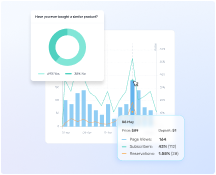With its rapid pace and dynamic nature (pun intended), the automotive industry is constantly evolving. The increasing demand for more efficient, safer, and environmentally friendly vehicles continually challenges manufacturers and marketers alike.
Conducting precise and effective automotive market research is not just beneficial but essential in this ever-changing landscape. This article serves as a guide for industry professionals and marketing experts, providing insights into understanding the complexities, executing proficient research, and achieving success in this competitive arena.
In this article, we will cover key strategies for effective market research, the latest trends driving the automotive sector, and practical tips for staying ahead in this fast-paced industry.
What Makes Market Research for the Automotive Industry Unique?
The automotive industry is a complex and ever-changing landscape, which makes market research there distinct from other sectors. Here’s what sets it apart:
Rapid Technological Advancements
The industry is constantly innovating with self-driving cars, electric vehicles, and new materials. Market research needs to stay on top of these trends to understand consumer needs and preferences for these evolving technologies.
High Focus on Consumer
Unlike some B2B industries, car manufacturers deal directly with consumers. Their needs and desires are paramount, so understanding their buying habits, preferences, and what features are most desirable is crucial.
Long Product Development Cycles
Cars take a long time to design, develop, and bring to market. Research needs to have a long-term perspective to ensure the vehicles resonate with future consumer demands.
Distinct Market Segments
The automotive market isn’t monolithic. There are luxury car buyers, budget-conscious consumers, eco-conscious drivers, truck enthusiasts, and more. Research needs to segment the market effectively to understand the specific needs of each group.
Globalized Market
Cars are manufactured and sold worldwide. Research must consider cultural nuances, government regulations, and infrastructure differences across various regions.
How to Do Automotive Market Research: A Step-by-Step Guide
The fast-paced world of automotive demands sharp market research skills. Here’s a step-by-step process to guide you:
1. Define Your Research Objectives
What specific questions do you have about the market? Are you interested in electric vehicle (EV) adoption rates among young adults, or luxury car buyer preferences for in-car technology? Clearly define your goals.
2. Select Your Research Methods
Understanding customer needs and preferences directly is crucial in the automotive industry. Here are some effective primary research methods you can leverage:
Primary Research Methods
Surveys: Online surveys are a cost-effective way to reach a large sample of potential customers. They allow you to gather quantitative data on demographics, preferences, and buying habits.
Example: Conduct an online survey to understand consumer interest in features like self-parking technology or sunroof options in a new compact car model.
Interviews: In-depth interviews allow for richer qualitative data. You can ask open-ended questions to delve deeper into consumer motivations, decision-making processes, and pain points.
Example: Interview recent car buyers to understand their experiences with the car-shopping process and dealership interactions. This can help identify areas for improvement in your sales strategy.
Focus Groups: Gather a small group of target consumers for a moderated discussion on a specific topic. This allows for interaction and exploration of ideas, revealing deeper insights and group dynamics.
Example: Organize a focus group with luxury car buyers to understand their perception of different brands, what features they value most, and their expectations for customer service.
Pro tip: What if there was a way to combine online surveys, interviews, and focus groups? Guess what, there is! Creating a landing page on Prelaunch is the perfect way to see how your audience interacts with your next vehicle. You can promote your page and share it with the world to find out who your target audience is, what features matter most to them, and what price they’d be willing to pay.
The platform embeds surveys along the user journey in a way that’s informative to you, the creator, and unintrusive to your potential leads. Another cool part of Prelaunch is you can streamline the process of conducting interviews and focus groups by speaking with people who have already confirmed their intent to buy.
Ethnographic Research: Observe consumers in their natural environment to understand their behavior and decision-making in real-world contexts. This can be particularly valuable for understanding car usage patterns and user experience.
Example: Observe families at car dealerships to see how they interact with different vehicles, what features they test out, and what influences their final decision.
Shop-Alongs: Accompany potential customers on their car shopping journey, either physically or virtually. This allows you to observe their interactions with salespeople, test drives, and decision-making process firsthand.
Example: Shop-along with first-time car buyers to understand any pain points they encounter during the process and identify areas where dealerships can provide better support.
Secondary Research Methods
Industry Reports: Market research firms like J.D. Power and Kelley Blue Book publish comprehensive reports on various automotive segments. These reports provide in-depth analysis on market size, trends, consumer preferences, competitor analysis, and sales forecasts.
Government Data: Government agencies like the Bureau of Transportation Statistics (US) and Eurostat (Europe) collect and publish data on vehicle registration, fuel efficiency trends, and consumer demographics. This data can reveal buying patterns and identify potential target markets.
Trade Publications: Industry publications like Automotive News and Ward’s Automotive provide news, analysis, and insights on current trends, technological advancements, and company strategies.
Company Websites and Annual Reports: Public information on company websites and annual reports can reveal competitor strategies, product roadmaps, and financial performance. Analyzing this data can help you benchmark your own offerings and identify potential gaps in the market.
Example: Study the annual report of a leading electric vehicle manufacturer like Tesla to understand their production capacity, future vehicle plans, and target markets. This can help you position your own EV offering strategically.
Customer Reviews and Social Media Data: Online platforms offer a treasure trove of customer sentiment analysis. Look for reviews on car-buying websites, social media discussions, and forums to understand customer experiences, buying considerations, and brand perceptions.
Pro tip: Use the AI Market Research Tool on Prelaunch. It can analyze thousands of reviews and feedback on Amazon to uncover the top customer praises and complaints. You may not think Amazon is big for cars, but it’s a well of untapped data.
By combining these methods and tailoring them to your specific research objectives, you can gain valuable insights into the hearts and minds of your target automotive market.
3. Determine Your Sample Size and Demographics
Ensure your sample group reflects your target market. So for instance, when surveying for self-driving car preferences, you wouldn’t want to target people who live exclusively in rural areas with limited highway access.
4. Design/Choose Your Research Instruments
Craft a questionnaire for surveys or a discussion guide for focus groups. Keep questions clear, concise, and relevant to your research objectives. Example: In your EV survey, questions could be: “What are the biggest barriers to purchasing an electric vehicle?” or “How important is charging infrastructure availability when considering an EV?”
Pro tip: Designing your own research instruments and collecting data is easier said than done. The process is very labor-intensive and time consuming if all done manually. Since trends in the automotive industry are also fleeting, you will probably not have the luxury of devoting that much time to designing your own research instruments. So try Prelaunch – when you create a landing page for your product on this platform, all data is collected in a single Dashboard. This means you don’t have to cross quantitative and qualitative insights manually. Rather it’s done for you.
From a demographic and psychographic breakdown of your audience to showing you the responses from surveys and focus groups, Prelaunch helps you gather all the information to make the most informed decisions.
5. Collect Your Data
Implement your chosen research methods. Pilot test surveys or discussion guides beforehand to ensure clarity and flow. If your running a prelaunch campaign this is what it will look like:
6. Analyze Your Data
Organize and interpret your findings. Look for trends, patterns, and key insights that answer your research questions. Use statistical analysis for quantitative data and thematic analysis for qualitative data (focus groups, interviews).
Pro tip: Crafting Customer Personas can significantly streamline the process of generating actionable insights. Prelaunch utilizes AI to create these personas from the customer profiles supplied by your campaign. In essence, as potential customers engage with your landing page, they reveal valuable information and clues about the most effective marketing strategies for your product (such as their key issues and the features they value most). Utilizing this data, Prelaunch formulates customer personas, offering you a precise understanding of whom to target and how to tailor your marketing strategies.
7. Formulate Your Recommendations
Based on your research, what actionable insights can you provide? Example: You might discover a strong demand for affordable, long-range EVs among young families. This could inform the development of a new EV model that caters to this specific market segment.
By following this step-by-step guide and tailoring it to your specific research goals, you can conduct effective market research that provides valuable insights for success in the dynamic automotive industry.
Tools and Resources for Automotive Market Research
Leveraging the right tools can immensely facilitate market research. Here’s a list of tools and resources to equip you for successful automotive market research:
Primary Research Tools
- SurveyMonkey: A user-friendly online survey platform that allows you to design, distribute, and analyze surveys to gather quantitative data from a large pool of respondents.
- Qualtrics: A powerful research software offering a suite of tools for surveys, online interviews, and advanced data analysis. It caters to complex research needs.
- Loop11: A video feedback platform that enables you to conduct remote, asynchronous interviews with target customers. Record video responses to open-ended questions for in-depth qualitative data.
- Prelaunch.com: An all-in-one platform that allows you to save millions in production and marketing before your next vehicle launch. It allows you to create a landing page and preview your product to potential customers before you shell out on manufacturing.
- UserTesting: A usability testing platform that allows you to recruit participants to test and provide feedback on prototypes, websites, or mobile apps related to your automotive research.
Secondary Research Tools:
- J.D. Power: A global leader in automotive consumer insights and data analytics. They publish comprehensive reports on customer satisfaction, vehicle quality, and purchase experience.
- Kelley Blue Book: Provides consumer research and automotive pricing information. They offer market reports and data on car valuations, helping you understand used car market trends.
- LMC Automotive: A leading provider of automotive forecasts and market intelligence. Their reports offer insights into production, sales, and future trends in the global automotive industry.
- Bureau of Transportation Statistics (US): A treasure trove of government data on vehicle registrations, fuel efficiency trends, and demographics in the United States.
- Eurostat (Europe): The statistical office of the European Union, providing a vast collection of data on various sectors, including the automotive industry.
These are just a few examples, and the best tools and resources for your research will depend on your specific needs and budget. Remember, market research is an ongoing process. Stay up-to-date with industry trends by following relevant publications:
- Automotive News: A leading industry publication providing news, analysis, and insights on current trends, technological advancements, and company strategies in the global automotive industry.
- Ward’s Automotive: Another industry publication offering news, data, and analysis on all aspects of the automotive industry, from design and manufacturing to sales and marketing.
Case Study: FUELL Flluid – Riding into Market Research Success
The FUELL Flluid case is a great example of automotive market research executed astutely. Although the company finds its subniche in electric mobility, there are still valuable lessons to be learned. Raising over $1.5M on Indiegogo, FUELL’s Flluid 2 and Flluid 3 e-bikes vividly demonstrate the power of an innovative product along with a meticulously planned campaign strategy backed by great research.
FUELL, founded by Erik Buell, a distinguished motorcycle engineer, aims to redefine urban mobility with advanced electric vehicles. It was this vision that Prelaunch was tasked with bringing to life through a comprehensive marketing strategy.
One key in their strategy was crafting an impactful prelaunch landing page. Through detailed breakdowns of the e-bike’s innovative features, showcasing testimonials from satisfied customers, and emphasizing the company’s history and expertise, the landing page was effective in creating credibility around the brand and product.
Engagement on the landing page then allowed the Prelaunch team to tailor social media and email marketing campaigns to continue building trust.
An effective PR strategy further boosted visibility and credibility, generating significant traffic to the campaign page. Flluid’s reviews on over 300 media outlets, including influential names like Forbes and Electrek, were repurposed for retargeting ads across all platforms.
Additionally, potential customers had the opportunity to test-ride the Flluid. This direct experience of the product’s capabilities fostered a sense of ownership and connection, driving the campaign’s success.
A live Q&A session provided direct engagement with potential backers, boosting product credibility, and customer confidence, and providing valuable insights for targeted marketing strategies.
Note: The Q&A proved just as insightful for those asking the questions as those answering. Q&As are like focus groups in that they offer direct contact with potential buyers and give exclusive access to what they are thinking, as well as what concerns and preferences they have.
In summary, the success of the FUELL Flluid crowdfunding campaign on Indiegogo was achieved through a combination of innovative market research, third-party reviews, and increasing product buzz. The campaign went beyond its fundraising goal of $30,000, setting a new standard for e-bike crowdfunding campaigns and validating the power of well-executed automotive market research.
Overcoming Challenges When Conducting Market Research in the Automotive Industry
The fast-paced and ever-evolving nature of the automotive industry presents unique challenges for market researchers. Here are some common hurdles you might encounter:
1. Rapid Technological Advancements
Challenge: Keeping up with the breakneck speed of technological advancements, like autonomous vehicles and electric vehicle innovations, can make it difficult to accurately gauge consumer needs and preferences for features that may not be readily available yet.
Overcome by: Conducting scenario planning and future-focused research. Analyze upcoming technological trends and potential consumer adoption rates. Partner with platforms like Prelaunch.com that can help you quickly preview your idea and get it.
2. High Cost of Entry
Challenge: In-depth market research, particularly primary research methods like surveys and focus groups, can be expensive to conduct.
Overcome by: Exploring alternative research methods. Utilize a mix of primary and secondary research methods. Consider online surveys and social media listening tools to gather cost-effective data. Partner with universities or research institutions for collaborative research projects.
3. Long Product Development Cycles
Challenge: The automotive industry has lengthy lead times for bringing new vehicles to market. By the time research is complete and reflected in car designs, consumer preferences may have shifted.
Overcome by: Implementing agile research practices. Conduct regular pulse surveys and focus groups to stay updated on evolving consumer needs. One way you can overcome this hurdle is to do a prelaunch campaign, begin together insights on which iteration of your automotive product people will want to see, refine your idea, and re-run the campaign again.
4. Global Market Complexity
Challenge: Understanding cultural nuances, government regulations, and infrastructure variations across different regions in a globalized market can be complex.
Overcome by: Partnering with local market research firms in target regions. Conduct region-specific research to tailor your understanding to individual markets. Leverage secondary data sources like government reports from various countries.
5. Shifting Consumer Preferences
Challenge: Consumer preferences and buying habits can change rapidly, especially with increasing environmental concerns and economic fluctuations.
Overcome by: Building a culture of continuous research. Conduct regular surveys and focus groups to track changing consumer attitudes. Utilize social media listening tools and competitor research tools to stay updated on online conversations and emerging trends.
By acknowledging these challenges and implementing the suggested solutions, you can ensure your market research remains relevant and provides valuable insights for success in the dynamic automotive industry.
Conclusion
Automotive market research is a formidable tool in the arsenal of industry professionals and marketers. It demands a nuanced understanding of the industry’s uniqueness, a strategic approach to data gathering and analysis, and an adeptness at overcoming inherent challenges. By following the outlined steps and employing the right tools, one can uncover invaluable insights that propel success in the fast-paced automotive industry.
FAQ (PAA Questions)
1. What is automotive market research?
Automotive market research is the systematic process of collecting, analyzing, and interpreting data to understand the automotive industry, customer needs, and market trends. It helps businesses make informed decisions about product development, marketing strategies, pricing, and overall brand positioning.
2. Who should be conducting automotive market research?
Several stakeholders within the automotive industry benefit from market research:
Automobile Manufacturers: They use research to understand consumer needs and preferences, identify emerging trends, and evaluate competitor offerings to develop successful new vehicles.
Distributors and Dealers: Market research helps them tailor their sales strategies to specific customer segments within their regions and optimize their inventory management.
Marketing and Advertising Agencies: Understanding market research data allows them to create targeted marketing campaigns that resonate with the right audience.
Suppliers and Aftermarket Parts Manufacturers: Research helps them identify market gaps and develop parts or technologies that address specific consumer demands.
Government Agencies and Regulatory Bodies: Market research informs policy decisions related to safety standards, fuel efficiency regulations, and infrastructure development for the automotive industry.
3. What types of market research are most appropriate for the automotive industry?
Both primary and secondary research methods are crucial for automotive market research:
Primary Research
- Focus groups and in-depth interviews provide valuable qualitative data on consumer motivations, preferences, and decision-making processes.
- Surveys gather quantitative data on demographics, buying habits, and feature preferences from a larger sample size.
Secondary Research
- Industry reports from J.D. Power or LMC Automotive offer valuable data on market size, trends, competitor analysis, and sales forecasts.
- Government data on vehicle registrations and fuel efficiency helps understand buying patterns and identify potential target markets.
- Analysis of customer reviews and social media conversations reveals real-world user experiences and brand perceptions.




